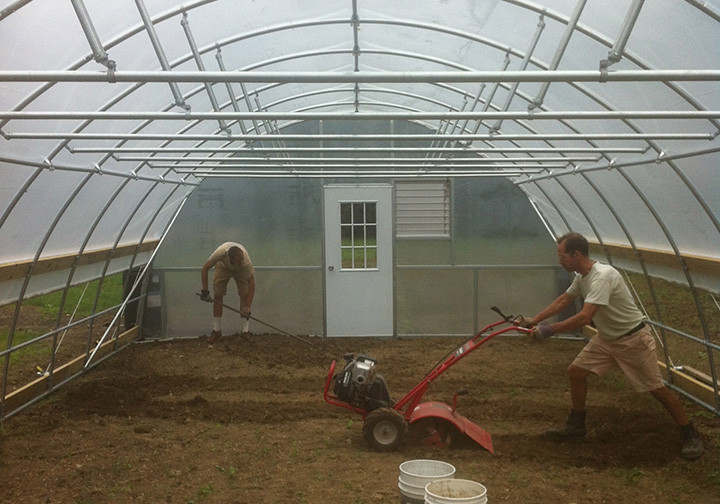What is a Hoop House and How do they Work? | Season Extension

If you're new to farming, or have only grown during the standard season, the term "Hoop House" might be foreign. For many small growers, however, hoop houses are a central part of their farm operation. If you came to get a crash course on the structures you're in the right place. So... what is a hoop house and how do they work?
Hoop Houses (High Tunnels) are plastic covered, unheated growing spaces that protect plants from rain, wind, and cold temperatures through passive solar heat gain; this allows growers to cultivate healthier crops through an extended growing season.
This means growers with a hoop house can:
- Plant sooner in the spring
- Harvest later into the fall
- Protect summer crops like tomatoes and cucumbers from rain and wind in the summer
- Harvest cold loving crops through the entire winter
- Bring in more revenue through the use of their protected growing space.
These structures also offer a form of protected growing; allowing water, light, and temperature to be controlled and monitored to a certain extent to meet specific crop needs.
What Defines a Hoop House
Hoop houses are generally constructed from hoops or bows as their main framing (quonset style). These hoops are where the structures got their name.
Hoop Houses can also contain peaked bows (gothic style) for easier snow-shed, but for the most part, people refer to these structures as High Tunnels.
If you're confused by the differences between a Hoop House and a High Tunnel or a High Tunnel and a Greenhouse... don't worry, we get it. We have a post that covers this a bit further: High Tunnels vs Greenhouses | Which Structure is Right for me.
Other Defining Features of a Hoop House
Typically, these structures also have:
- Framed end-walls to allow doors and vents to be installed, which differs from caterpillar tunnels, which typically don't come with end-wall framing or doors.
- Sides that roll-up to manage heat in the warmer months.
- 6mil-12mil polyethylene cover. The type of covering selected will affect both heat and light, as discussed in the next section.
- No permanent utility hook-ups like heat or water lines
Hoop houses are unheated structures, and are designed to be cost effective. Avoiding permanent utility hook-ups often also results in these structures not requiring permits for assembly... check your local building department though, as all municipalities are different.
How Hoop Houses Keep Heat
The covering on a hoop house facilitates the greenhouse effect; allowing the sun’s natural ultraviolet radiation (light) and infrared radiation (heat) to pass through the covering. The plastic cover traps infrared radiation, thereby heating the air and materials inside (reference greenhouse effect).
As the sun’s rays pass through the poly covering they are dispersed throughout the space and heat can be absorbed by plants, the soil, any thermal banks (drums of water, stone, etc.) which will slowly release the heat overnight.
Impact of Hoop House Design on Light and Heat
Hoop houses are not only beneficial for simple design, construction, and reduced building costs, they are also more effective in terms of light and heat transmission from the sun.
The suns rays transmit the most light/heat at a 90 degree orientation, consequently the more surface area exposed at the greatest angle, increases the light and heat that is available.
During the summer the sun is more directly overhead, and during the winter it is lower in the sky, so a more gradual angle (round) allows more surface area access to light transmission throughout the entire year. Source Publication
Hoop House Coverings
A quality poly covering with focused management of internal row covers and low tunnels can result in a 30*F temperature differential between the outside and inside of a hoop house overnight, without supplemental heat (reference publication).
Some growers also install a double layer inflated covering for up to 40% more heat retention (reference publication), which can be highly beneficial in cold climates.
In addition, a poly covering can have an IRAD coating applied which can also mitigate some heat loss and limit internal condensation development. It should be noted that all coverings have a life span, and as time passes light transmission and coating effectiveness decrease, requiring the covering to be replaced every few years.
Other Considerations
As stated earlier, hoop houses are unheated structures, but that isn’t to say that heat can’t be added if desired. Some growers will operate heaters and install additional insulation on the end-walls during the coldest months of the year, and perhaps even supplemental lighting.
This is where additional hoop house framing and structural components may be necessary to support the needs of a particular hoop house. Additionally, the greenhouse effect applies year-round. This can result in temperatures that exceed crop recommendations in the summer months; exhaust ventilation, roll-up sides, watering systems, and shade cloth may also be necessary to control temperature extremes.
Hoop houses can be incredibly advantageous structures for growers to increase crop productivity with the increased measures of heat retention and controls that they provide. With simple construction, use of passive solar radiation via the greenhouse effect, and appropriate poly coverings they can provide the opportunity for affordable year round crop production.
RELATED POSTS:

